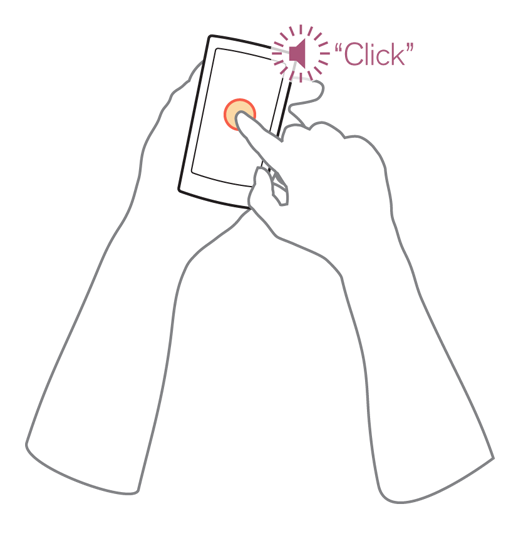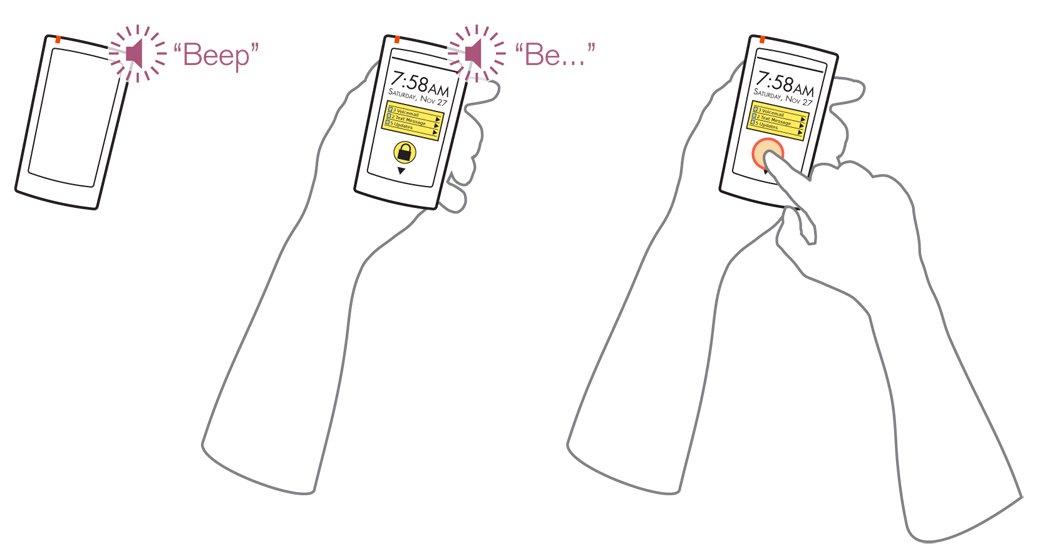|
Size: 9286
Comment:
|
Size: 9314
Comment:
|
| Deletions are marked like this. | Additions are marked like this. |
| Line 31: | Line 31: |
| Use caution with reminder alerts, or repeatedly announcing the same alert again. This should generally only be used for conditions that are time sensitive and require the user to perform a real-world action, such as an alarm clock. There is generally no need to repeatedly sound an audible alert for ****** (missing content?) | Use caution with reminder alerts, or repeatedly announcing the same alert again. This should generally only be used for conditions that are time sensitive and require the user to perform a real-world action, such as an alarm clock. There is generally no need to repeatedly sound an audible alert for normal priority items such as email or sms messages. |
Problem
Non-verbal auditory tones must be used to provide feedback or alert users to conditions or events, but must not becoming confusing, lost in the background or so frequent that critical alerts are disregarded.

Solution
Interaction design, like much design work, focuses heavily on the visual components. However, users of all devices have a multitide of senses, all of which can and should be engaged to provide a more complete experience.
Mobiles are carried all the time, often out of sight, and must use Tones and Haptic Output to get the user's attention, or to communicate information more rapidly and clearly. Tones should be used not just for alerting, but as a secondary channel to emphasize successful input, such as on-screen and hardware button presses, scrolls and other interactions.
Alerts are used to regain user focus on the device. Additional communication can then be made to the user, usually visually, with on-screen display of Notifications or other features. However, this may also involve Voice Readback or initiating Voice Reminders.
Whenever implementing this pattern, be aware of the danger of the "better safe than sorry" approach to auditory Tones. Too much sound can be as bad as too little by adding confusion or inducing "alarm fatigue." At it's worse, this can be akin to "banner blindness" with some or all device tones simply edited out by the user's brain.
Variations
Feedback tones are used to provide direct response to a user action. The tone serves as an alternate and immediate feedback that the user action has been accepted by the system. This is usually a direct action such as a button press or gesture. Feedback developed in the machine era, as a result of the user's fingers and hands obscuring the input devices; even when a button moved, or illuminated, more efficient input was assured by the inclusion of auditory and Haptic Output.
Alerts serve to notify the user of a condition that occurs independent of action, such as a calendar appointment or new SMS. These also date back far before electronic systems. Due to the multitude of alarms, control systems such as aircraft and power plants are more useful antecedents to study than simple items like alarm clocks.
Delayed response alerts exist in a difficult space between these two. For example, when an action is submitted, and a remote system responds with an error several seconds later. The response is in context, so is similar to a feedback tone, but needs to meet the needs of informing the user to look at the screen again, much as an alert.
Interaction Details
Phenomena like the McGurk effect -- where speech comprehension is related to the visual component -- appear to exist for other types of perception. Tones should support interaction with the visual portions of the interface.
Tones must always correspond to at least one visual or tactile component. If an alert sounds, it should always have a clear, actionable on-screen element. These should always appear in the expected manner for the type of event. Feedback tones correspond to keypresses or other actions the user takes, and alert tones should display in the conventional method the device uses for Notifications.
Displayed notifications must not disappear without deliberate user input. Users may not be able to see the screen or act on a particular alert for some time; the visual display to explain the alert must remain in place.
Use caution with reminder alerts, or repeatedly announcing the same alert again. This should generally only be used for conditions that are time sensitive and require the user to perform a real-world action, such as an alarm clock. There is generally no need to repeatedly sound an audible alert for normal priority items such as email or sms messages.
Alert silencing -- removing the auditory portion, or the audible and LED blinking portion of an alert -- should be unrelated to any other notifications. It should be possible to silence an alert without dismissing the entire condition. Often, this can be done by simply opening or unlocking the device; if previously in a locked mode, the assumption can be made that the user has seen and acknowledged all conditions.

Presentation Details
The tone must correspond to the class and type of action and should imply something about the action by the type of tone. Clicks denote keypresses, whereas buzzers denote errors for example.
Sound design is an entire field of study. If sounds must be created from scratch, a sound designer should be hired to develop the tones based on sound principles. Be sure to denote the meaning -- and emotional characteristics -- for each sound.
Vibration and audio are closely coupled, so should be considered hand in hand. If Tones are used in concert with Haptic Output, assure they do not conflict with each other. For devices without haptic or vibration hardware, audio can serve this need in a limited manner. Short, sharp tones provided through the device speaker can provide a tactile response greater that their audio response.
The illusory continuity of tones can be exploited in a manner similar to how persistence of vision is for video playback. Simple tones can be output with gaps or in a rapid stairstep and be perceived to be a continuous tone. This is especially to simulate higher fidelity audio than can be achieved on devices with constrained processing hardware.
Do not allow alerts or other Tones to over-ride voice communications. Many other types of audio output, such as video or music playback, may also demand some tones be greatly reduced or entirely eliminated. Do not play multiple tones at one time.
Generally, alerts can be grouped. If three calendar appointments occur at the time time, only one alert Tone needs to be played, not three in sequence. Never play more than one tone at a time.
Use caution with the display of multiple alerts at closely following each other. If the user has not acknowledged an incoming SMS, and a new voicemail arrives moments later, there may be no need to play the second alert tone. The delay time required to play a second alert Tone is dependent on the user, the type of alert, and the context of use.
Carefully consider audibility, or how any sound can be perceived as separate from the background. Automatic adjustments may be used by opening the microphone and analyzing ambient noise. However, do not simply make sounds louder to compensate for this, but adjust tone or select pre-built variations more appropriate to the environment.
Be aware of the relationship between pitch and sound pressure, and adjust based on output volume. Consider using auditory patterns (or tricks) like Sheppard-Risset tones to simulate rising or falling tones.
Antipatterns
Alarm fatigue is the greatest risk when designing notification or response Tones. If tones are too generic, too common or too similar to other tones in the environment (whether similar to natural sounds or electronic tones from other devices) they can be discounted by the user. Use as few different sounds as possible.
This may be deliberate, where the user consciously discards "yet another alert" for a time, or unconscious as the user's auditory center eventually filters out repeated tones as noise. This can even result in users sleeping through quite loud alarms due to the tone being considered noise by their brain.
Do not go too far the other way, and have no auditory feedback, especially for errors. Delayed response conditions are especially prone to having no audible component. This induces a great risk in users who may believe they have sent a message or set a condition to be alerted later, and may not look at the device for some time.
It is even possible for accidental entry, or deliberate eyes-off entry, to clear a visible error so users are not informed of alerts or delayed responses at all. Be sure to use notification Tones whenever the condition calls for it.
